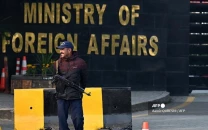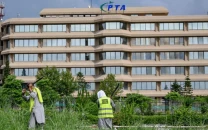CM unveils plan to boost agriculture sector
Four-year package to support small growers with farm mechanisation

Sindh Chief Minister Murad Ali Shah has said that his government aims to implement several initiatives to enhance the overall agriculture system in the province, including farm mechanisation and subsidies on agricultural inputs for wheat and rice crops, for which he directed the agriculture department to develop a four-year package for small growers.
CM Shah directed agriculture, food, and irrigation departments to collaborate in educating growers about the latest technology, water availability, and modern farming practices. He highlighted the importance of understanding water availability for crop planning and emphasised that growers should focus on cultivating profitable crops.
He said this while presiding over a joint meeting of the agriculture, food, and irrigation departments at the CM House.
He emphasised that under farm mechanisation, laser land levelling and Manual Seeder Hand Pusher should be introduced for small growers with holdings of one to 25 acres of land. He added that land levelling should be offered on a rental basis to growers of that size.
The CM also remarked that subsidies on agricultural inputs for wheat and rice crops could be provided, particularly for seeds, fertilisers, and herbicides/pesticides aimed at small growers (one to 25 acres).
Laser Land Levelling
CM Shah highlighted that levelling land using laser technology could conserve 20 to 30 per cent of irrigation water. This approach could also yield an increase of six to 10 per cent, while reducing irrigation time by 50 per cent. The overall result would be a 20 per cent boost in income, along with the prevention of waterlogging and salinity, and a more balanced use of agricultural inputs.
Regarding the Manual Seeder Hand Push Planter, the CM stated that a study showed this tool could reduce planting time and labour by 20 to 30 per cent. It would ensure 90 to 95 per cent accuracy in seed placement and spacing, leading to a 40 to 50 per cent decrease in physical strain on farmers. Additionally, using this planter could increase crop yields by 10 to 20 per cent, reduce soil disturbance and erosion by 20 per cent to 30 per cent, and lower planting costs by five per cent to 25 per cent.
The Chief Minister was then informed that there are 3,552,980 acres of land in the province owned by holders with one to 25 acres each. To level these 3.5 million acres, 2,961 laser levellers will be needed over three years.
Overall impact
The chief minister was advised that the overall impact of the subsidy on agricultural inputs could lead to a 13 per cent increase in the production of wheat and rice crops through seed subsidies, a five per cent increase in production from DAP and urea subsidies, and a five per cent increase in production from herbicide and pesticide subsidies, respectively.
Additionally, the CM was informed that wheat is cultivated in Sindh over an area of 3.1 million acres, while rice covers two million acres, requiring 3.8 million maunds of seed for wheat and 0.99 million maunds for rice. Against this requirement, 3.2 million maunds of wheat seed and 0.942 million maunds of rice seed are available in the market, indicating a shortfall of 0.6 million maunds of wheat and 45,423 maunds of rice seeds. In response, the CM instructed the agriculture department to ensure the availability of the necessary certified seed by all means possible.
Murad Shah instructed that the agriculture, food, and irrigation departments' collaboration is essential to educate growers about the latest technology, water availability, and modern farming practices in a timely manner. "It is important for growers to be aware of water availability so they can plan their crops accordingly," he emphasised. He also noted that growers should understand which crops have market value to ensure they cultivate those that are profitable.



















COMMENTS
Comments are moderated and generally will be posted if they are on-topic and not abusive.
For more information, please see our Comments FAQ